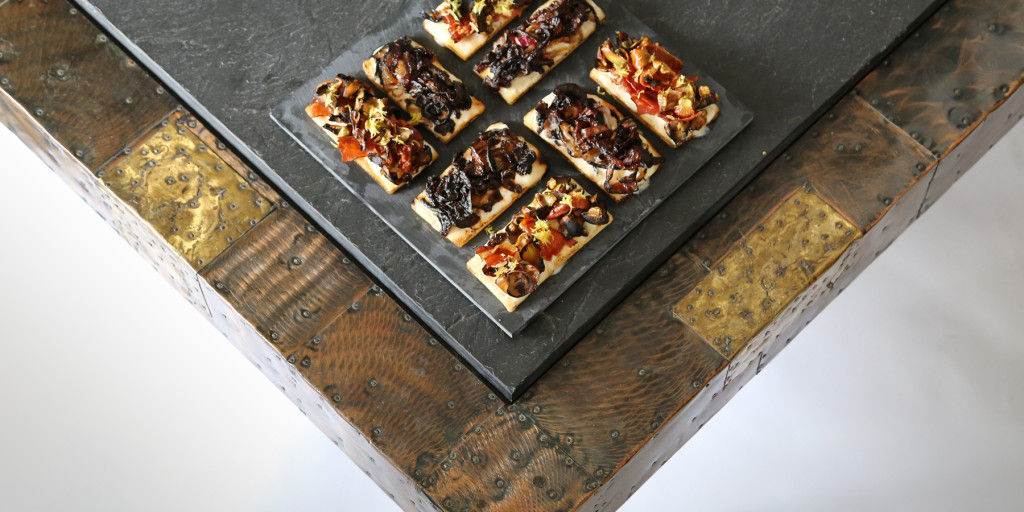
September 3, 2014New York-based private chef Antoni Porowski (center) recently teamed up with 1stdibs dealers Barry Rice (left) and Roger Ward of Full Circle Modern, a Brooklyn gallery specializing in 20th-century furniture, to create a cocktail menu inspired by design.
Synesthesia is a neurological condition in which one sense is linked to another. For people who have it, letters, shapes and even names have the power to produce sensations of color, scent or flavor. So a synesthete may feel ticklish when looking at orange or smell pine trees when hearing a piano. Or, in the case of New York-based private chef Antoni Porowski, he may taste the contours of a Karl Springer console.
In the highly unscientific experiment that follows, we had Porowski team up with 1stdibs dealers Barry Rice and Roger Ward of Full Circle Modern, a Brooklyn gallery specializing in 20th-century furniture and lighting, to create a menu of hors d’oeuvres all inspired by design. As Porowski spent time in the gallery (Rice is a friend and frequent client), he couldn’t help but examine the pieces. “The items started to have a transportive effect on me — they’d take me to very specific times and places,” he says. “And this immediately made me think of my cooking.” The textures, shapes and finishes of furniture became analogous to ingredients, and the rotating nature of Full Circle’s inventory seemed not unlike the seasonal rotations at a farmer’s market. Though undiagnosed, Porowski’s “synesthesia” was quickly identified by key editors at Introspective.
Read on for the stories behind Porowski’s dishes, then head to 1stdibs’ blog, The Study, to get all the recipes.
PAUL EVANS Tarte flambée
with caramelized onions, prosciutto and fried artichokes
Evans was a masterful metalsmith, so wield a kitchen torch with similar aplomb.
It’s no surprise that Paul Evans, a leading proponent of Brutalist design, inspired Porowski to create a rough-hewn tarte flambée. This Alsatian peasant dish — a traditional food of the region’s farmworkers — exploded in popularity during the ’60s in the U.S. Topped with artichoke, caramelized onion and prosciutto, Porowski’s tarte has a similar patina as Evans’s pieces fashioned from mosaics of copper, bronze and pewter, like the coffee table below. Evans frequently used new technology to recreate artisanal techniques, so Porowski applied the same method, using a blowtorch to burnish his dish, adding just a bit of char and depth of color to the final product.

Paul Evans patchwork coffee table, ca. 1970s
Charles Hollis Jones Aspic Dome
with smoked chicken liver pâté and suspended asparagus spears
An homage to Jones calls for a dish with retro élan.
Designer Charles Hollis Jones used a fighter-jet manufacturer’s facilities to create a solid-Lucite cast for the bullet-shaped base of his Le Dome table. So when Rice calls it “an engineering accomplishment,” he does so without hyperbole. For Porowski, the table’s translucence and smoky charcoal color — an exceedingly rare hue for Jones — recall that of aspic. With its retro-kitsch appeal, the savory gelatin seems to mimic Jones’s design. Asparagus spears pierce the mold, echoing the inlaid bronze hardware Jones used to secure the thick acrylic tabletop. And in a nod to its scale-tipping heft, Porowski punctuated the dish with slices of decadent chicken liver pâté.

Charles Hollis Jones Le Dome dining table, ca. 1970s
ROBERT SONNEMAN Caprese Bites
with tomato, watermelon and balsamic vinegar “pearls”
Molecular gastronomy meets molecular design in a Caprese for the Atomic Age.
Comprised of a series of ball-and-socket joints, this chrome lamp — attributed to lighting designer Robert Sonneman — was dubbed a “living sculpture” by Rice. Porowski sought to capture its sense of motion by transforming the summer staple Caprese salad into bite-size hors d’oeuvres. The lamp’s Space-Age sensibility is slyly invoked with suspended solid “pearls” of balsamic vinegar — a pleasing party trick ripped from the pages of modernist cuisine.
KARL SPRINGER Mango Sticks
with chili-sugar-salt rub
A German modernist walks into an Indonesian food stall . . .
“Springer was a master when it came to wrapping furniture,” notes Rice. That method is showcased in a wooden console table covered in lacquered Indonesian batik fabric, created in the style of the German-born designer. Crunchy, unripe mango sticks, meanwhile, are a common street food in Southeast Asia and have the same vibrant palette as Springer’s pieces. Porowski found the natural variations in the print “gave the pieces a sense of energy and movement,” which he translated into a lively chili-sugar salt rub used to coat the fruit — a gesture that mimics the enveloping technique.
MILO BAUGHMAN Parmesan Crisps
with fig ricotta dip
Comfort food with elegant lines? Baughman would approve.
Milo Baughman may have had the most exotic name in Kansas’s history. To honor his Midwestern heritage, Porowski began with the concept of crowd-pleasing cheese dip, and, in a nod to Baughman’s unfailing elegance, dressed it up with whipped ricotta blended with roasted figs. The whole dish has a whiff of the ’70s to it — there’s just something decadent about cheese on cheese — an era whose glamorous-yet-earthy vibe is exemplified by Baughman’s deft pairing of shiny chrome and caning. “The chair’s back has a lovely, graceful arch,” Rice notes — a feature Porowski echoed with thin crosshatched Parmesan crisps. “These chairs are extraordinarily comfortable, great for a dinner party that keeps on going.”

Milo Baughman dining chair, ca. 1970s









